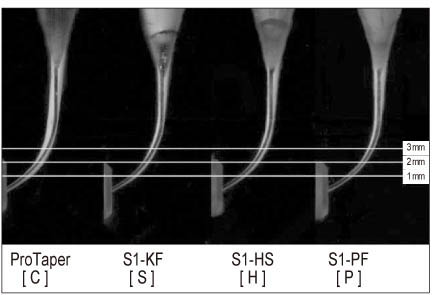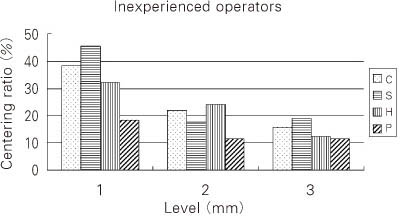J Korean Acad Conserv Dent.
2006 Jan;31(1):11-19. 10.5395/JKACD.2006.31.1.011.
Comparison of shaping ability between various hybrid instrumentation methods with ProTaper
- Affiliations
-
- 1Department of Conservative Dentistry, College of Dentistry, Pusan National University, Korea. golddent@pusan.ac.kr
- KMID: 2175776
- DOI: http://doi.org/10.5395/JKACD.2006.31.1.011
Abstract
- The purpose of this study was to compare and evaluate the shaping abilities of various hybrid instrumentation method using constant tapered file systems with ProTaper(R) S1 and the difference between experts and inexperienced clinicians in use of NiTi file. Three hybrid methods used in this study were composed of ProTaper(R) S1 and K-Flexofile(R) (group S), ProTaper(R) S1 and HeroShaper(R) (group H), and ProTaper(R) S1 and ProFile(R) (group P), respectively. The ProTaper(R)-alone method (group C) was introduced as a control group. After canal preparation, the lapse of time was recorded. The images of pre- and post-operative canal were scanned and superimposed. Amounts of instrumented canal widths and centering ratio were measured at apical 1, 2 and 3 mm levels and statistical analysis was performed. In this study, both of the group C and S took more time to prepare canals than other groups. Inexperienced operators required more time for the entire preparation with the groups C and H than the experienced (p < 0.05). And the centering ratio of group P were preferable to ProTaper(R)-alone method or the hybrid technique using stainless steel files. As such, within experienced operators, group H also showed better results in addition to the group P. Under these condition, the hybrid methods of each the ProFile(R) system and HeroShaper(R) with ProTaper(R) are recommendable comparative to ProTaper(R)-alone method. According to the results, the hybrid instrumentation method is a more appropriate method of canal preparation than single file system for narrow or curved canals.
Keyword
MeSH Terms
Figure
Cited by 3 articles
-
Comparison of shaping ability between single length technique and crown-down technique using Mtwo rotary file
Yoo-Kyoung Lim, Jeong-Kil Park, Bock Hur, Hyeon-Cheol Kim
J Korean Acad Conserv Dent. 2007;32(4):385-396. doi: 10.5395/JKACD.2007.32.4.385.Comparison of shaping ability using various Nickel-Titanium rotary files and hybrid technique
Jung-Won Kim, Jeong-Kil Park, Bock Hur, Hyeon-Cheol Kim
J Korean Acad Conserv Dent. 2007;32(6):530-541. doi: 10.5395/JKACD.2007.32.6.530.Mechanical and geometric features of endodontic instruments and its clinical effect
Hyeon-Cheol Kim
J Korean Acad Conserv Dent. 2011;36(1):1-11. doi: 10.5395/JKACD.2011.36.1.1.
Reference
-
1. Walia H, Brantley WA, Gerstein H. An initial investigation of the bending and torsional properties of Nitinol root canal files. J Endod. 1988. 14(7):346–351.
Article2. Schafer E, Schulz-Bongert U, Tulus G. Comparison of hand stainless steel and nickel titanium rotary instrumentation: a clinical study. J Endod. 2004. 30(6):432–435.
Article3. Chen JL, Messer HH. A comparison of stainless steel hand and rotary nickel-titanium instrumentation using a silicone impression technique. Aust Dent J. 2002. 47(1):12–20.
Article4. Garip Y, Gunday M. The use of computed tomography when comparing nickel-titanium and stainless steel files during preparation of simulated curved canals. Int Endod J. 2001. 34(6):452–457.
Article5. Glossen CR, Haller RH, Dove SB, Delrio CE. A comparison of root canal preparation using NiTi hand, NiTi engine driven and K-Flex endodontic instruments. J Endod. 1995. 21:146–151.6. Schafer E. Shaping ability of Hero 642 rotary nickel-titanium instruments and stainless steel hand K-Flexofiles in simulated curved root canals. Oral Surg Oral Med Oral Pathol Oral Radiol Endod. 2001. 92(2):215–220.
Article7. Park H. A comparison of Greater Taper files, Profiles and stainless steel files to shape curved root canals. Oral Surg Oral Med Oral Pathol Oral Radiol Endod. 2001. 91(6):715–718.
Article8. Ankrum MT, Hartwell GR, Truitt JE. K3 Endo, ProTaper, and ProFile systems: breakage and distortion in severely curved roots of molars. J Endod. 2004. 30(4):234–237.
Article9. Bergmans L, Van Cleynenbreugel J, Beullens M, Wevers M, Van Meerbeek B, Lambrechts P. Progressive versus constant tapered shaft design using NiTi rotary instruments. Int Endod J. 2003. 36(4):288–295.
Article10. Clauder T, Baumann MA. ProTaper NT system. Dent Clin North Am. 2004. 48(1):87–111.
Article11. Peters OA, Peters CI, Barbakow F. ProTaper rotary root canal preparation: effects of canal anatomy on final shape analysed by micro CT. Int Endod J. 2003. 36(2):86–92.
Article12. Calberson FL, Deroose CA, Hommez GM, De Moor RJ. Shaping ability of ProTaper nickel-titanium files in simulated resin root canals. Int Endod J. 2004. 37(9):613–623.
Article13. Yun HH, Kim SK. A comparison of the shaping abilities of 4 nickel-titanium rotary instruments in simulated root canals. Oral Surg Oral Med Oral Pathol Oral Radiol Endod. 2003. 95(2):228–233.
Article14. Schafer E, Vlassis M. Comparative investigation of two rotary nickel-titanium instruments: ProTaper versus RaCe. Part 1. Shaping ability in simulated curved canals. Int Endod J. 2004. 37(4):229–238.
Article15. Berutti E, Chiandussi G, Gaviglio I, Ibba A. Comparative analysis of torsional and bending stresses in two mathematical models of nickel-titanium rotary instruments: ProTaper versus ProFile. J Endod. 2003. 29(1):15–19.
Article16. Walsch H. The hybrid concept of nickel-titanium rotary instrumentation. Dent Clin North Am. 2004. 48:183–202.
Article17. Park SH, Cho KM, Kim JW. The Efficiency of the Ni-Ti Rotary files in Curved Simulated Canals Shaped by Novice Operators. J Korean Acad Conserv Dent. 2003. 28(2):146–155.
Article18. Calhoun G, Montgomery S. The effects of four instrumentation techniques on root canal shape. J Endod. 1988. 14(6):273–277.
Article19. Kosa DA, Marshall G, Baumgartner JC. An analysis of canal centering using mechanical instrumentation techniques. J Endod. 1999. 25(6):441–445.
Article20. Szep S, Gerhardt T, Leitzbach C, Luder W, Heidemann D. Preparation of severely curved simulated root canals using engine-driven rotary and conventional hand instruments. Clin Oral Investig. 2001. 5(1):17–25.
Article21. Peters OA. Current Challenges and Concepts in the Preparation of Root Canal Systems: A Review. J Endod. 2004. 30(8):559–567.
Article22. Hata G, Uemura M, Kato AS, Imura N, Novo NF, Toda T. A comparison of shaping ability using ProFile, GT file, and Flex-R endodontic instruments in simulated canals. J Endod. 2002. 28(4):316–321.
Article23. Kim HC, Park JK, Hur B. Relative efficacy of three Ni-Ti file systems used by undergraduates. J Korean Acad Conserv Dent. 2005. 30(1):38–48.
Article24. Park WK, Lee HJ, Hur B. Shaping ability of nickel-titanium rotary files. J Korean Acad Conserv Dent. 2004. 29(1):44–50.25. Powell SE, Simon JHS, Maze B. A comparison of the effect of modified and nonmodified instrument tips on apical canal configuration. J Endod. 1986. 12:293–300.
Article26. Griffiths IT, Bryant ST, Dummer PM. Canal shapes produced sequentially during instrumentation with Quantec LX rotary nickel-titanium instruments: a study in simulated canals. Int Endod J. 2000. 33:346–354.
Article27. Iqbal MK, Firic S, Tulcan J, Karabucak B, Kim S. Comparison of apical transportation between ProFile and ProTaper NiTi rotary instruments. Int Endod J. 2004. 37(6):359–364.
Article28. Garala M, Kuttler S, Hardigan P, Steiner-Carmi R, Dorn S. A Comparison of the minimum canal wall thickness remaining following preparation using two nickel-titanium rotary systems. Int Endod J. 2003. 36:636–642.
Article29. González-Rodrguez MP, Ferrer-Luque CM. A comparison of Profile, Hero 642, and K3 instrumentation systems in teeth using digital imaging analysis. Oral Surg Oral Med Oral Pathol Oral Radiol Endod. 2004. 97(1):112–115.
Article30. Thompson SA, Dummer PMH. Shaping ability of Hero642 rotary nickel-titanium instruments in simulated root canals: Part 1. Int Endod J. 2000. 33:248–254.
Article
- Full Text Links
- Actions
-
Cited
- CITED
-
- Close
- Share
- Similar articles
-
- Comparison of shaping ability using various Nickel-Titanium rotary files and hybrid technique
- A comparison of shaping ability of the three ProTaper(R) instrumentation techniques in simulated canals
- A comparison of the shaping ability of reciprocating NiTi instruments in simulated curved canals
- A comparative study of the canal configuration after shaping by protaper rotary and hand files in resin simulated canals
- Shaping ability and apical debris extrusion after root canal preparation with rotary or reciprocating instruments: a micro-CT study





